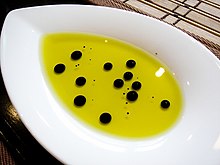


Phase separation is the creation of two distinct phases from a single homogeneous mixture.[1] The most common type of phase separation is between two immiscible liquids, such as oil and water. This type of phase separation is known as liquid-liquid equilibrium. Colloids are formed by phase separation, though not all phase separations forms colloids - for example oil and water can form separated layers under gravity rather than remaining as microscopic droplets in suspension.
A common form of spontaneous phase separation is termed spinodal decomposition; it is described by the Cahn–Hilliard equation. Regions of a phase diagram in which phase separation occurs are called miscibility gaps. There are two boundary curves of note: the binodal coexistence curve and the spinodal curve. On one side of the binodal, mixtures are absolutely stable. In between the binodal and the spinodal, mixtures may be metastable: staying mixed (or unmixed) absent some large disturbance. The region beyond the spinodal curve is absolutely unstable, and (if starting from a mixed state) will spontaneously phase-separate.
The upper critical solution temperature (UCST) and the lower critical solution temperature (LCST) are two critical temperatures, above which or below which the components of a mixture are miscible in all proportions. It is rare for systems to have both, but some exist: the nicotine-water system has an LCST of 61 °C, and also a UCST of 210 °C at pressures high enough for liquid water to exist at that temperature. The components are therefore miscible in all proportions below 61 °C and above 210 °C (at high pressure), and partially miscible in the interval from 61 to 210 °C.[2][3]
- ^ Nic M, Jirat J, Kosata B (1997). "Phase separation". In McNaught AD, Wilkinson A, Jenkins A (eds.). IUPAC Compendium of Chemical Terminology (the "Gold Book") (2nd ed.). Oxford: Blackwell Scientific Publications. doi:10.1351/goldbook.P04534. ISBN 0-9678550-9-8.
- ^ P.W. Atkins and J. de Paula, "Atkins' Physical Chemistry" (8th edn, W.H. Freeman 2006) pp. 186-7
- ^ M. A. White, Properties of Materials (Oxford University Press 1999) p. 175